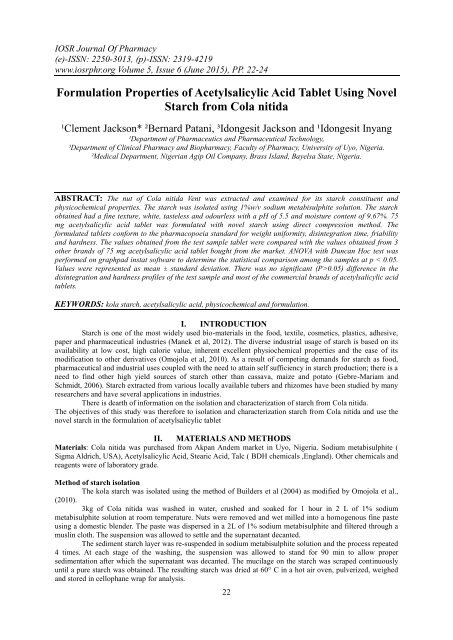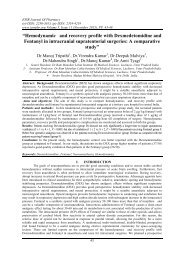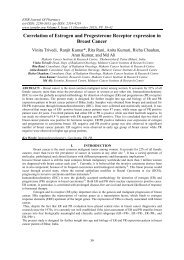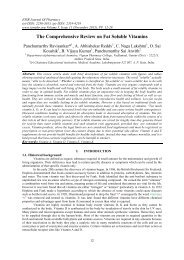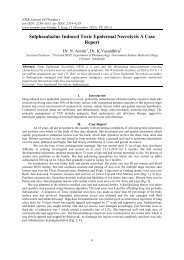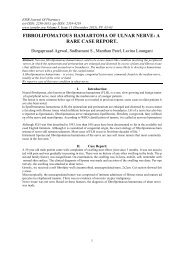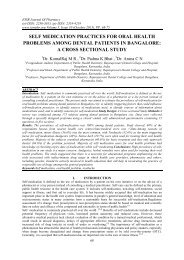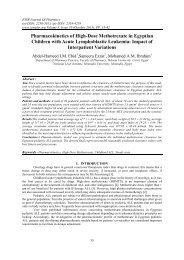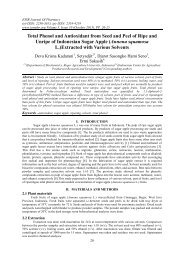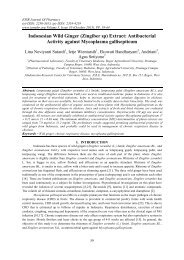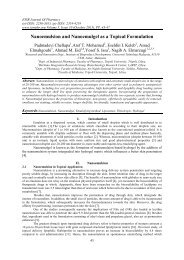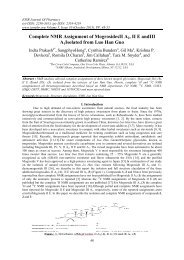Formulation Properties of Acetylsalicylic Acid Tablet Using Novel Starch from Cola nitida
Create successful ePaper yourself
Turn your PDF publications into a flip-book with our unique Google optimized e-Paper software.
IOSR Journal Of Pharmacy<br />
(e)-ISSN: 2250-3013, (p)-ISSN: 2319-4219<br />
www.iosrphr.org Volume 5, Issue 6 (June 2015), PP. 22-24<br />
<strong>Formulation</strong> <strong>Properties</strong> <strong>of</strong> <strong>Acetylsalicylic</strong> <strong>Acid</strong> <strong>Tablet</strong> <strong>Using</strong> <strong>Novel</strong><br />
<strong>Starch</strong> <strong>from</strong> <strong>Cola</strong> <strong>nitida</strong><br />
¹Clement Jackson* ²Bernard Patani, ³Idongesit Jackson and ¹Idongesit Inyang<br />
¹Department <strong>of</strong> Pharmaceutics and Pharmaceutical Technology,<br />
³Department <strong>of</strong> Clinical Pharmacy and Biopharmacy, Faculty <strong>of</strong> Pharmacy, University <strong>of</strong> Uyo, Nigeria.<br />
²Medical Department, Nigerian Agip Oil Company, Brass Island, Bayelsa State, Nigeria.<br />
ABSTRACT: The nut <strong>of</strong> <strong>Cola</strong> <strong>nitida</strong> Vent was extracted and examined for its starch constituent and<br />
physicochemical properties. The starch was isolated using 1%w/v sodium metabisulphite solution. The starch<br />
obtained had a fine texture, white, tasteless and odourless with a pH <strong>of</strong> 5.5 and moisture content <strong>of</strong> 9.67%. 75<br />
mg acetylsalicylic acid tablet was formulated with novel starch using direct compression method. The<br />
formulated tablets conform to the pharmacopoeia standard for weight uniformity, disintegration time, friability<br />
and hardness. The values obtained <strong>from</strong> the test sample tablet were compared with the values obtained <strong>from</strong> 3<br />
other brands <strong>of</strong> 75 mg acetylsalicylic acid tablet bought <strong>from</strong> the market. ANOVA with Duncan Hoc test was<br />
performed on graphpad instat s<strong>of</strong>tware to determine the statistical comparison among the samples at p < 0.05.<br />
Values were represented as mean ± standard deviation. There was no significant (P>0.05) difference in the<br />
disintegration and hardness pr<strong>of</strong>iles <strong>of</strong> the test sample and most <strong>of</strong> the commercial brands <strong>of</strong> acetylsalicylic acid<br />
tablets.<br />
KEYWORDS: kola starch, acetylsalicylic acid, physicochemical and formulation.<br />
I. INTRODUCTION<br />
<strong>Starch</strong> is one <strong>of</strong> the most widely used bio-materials in the food, textile, cosmetics, plastics, adhesive,<br />
paper and pharmaceutical industries (Manek et al, 2012). The diverse industrial usage <strong>of</strong> starch is based on its<br />
availability at low cost, high calorie value, inherent excellent physiochemical properties and the ease <strong>of</strong> its<br />
modification to other derivatives (Omojola et al, 2010). As a result <strong>of</strong> competing demands for starch as food,<br />
pharmaceutical and industrial uses coupled with the need to attain self sufficiency in starch production; there is a<br />
need to find other high yield sources <strong>of</strong> starch other than cassava, maize and potato (Gebre-Mariam and<br />
Schmidt, 2006). <strong>Starch</strong> extracted <strong>from</strong> various locally available tubers and rhizomes have been studied by many<br />
researchers and have several applications in industries.<br />
There is dearth <strong>of</strong> information on the isolation and characterization <strong>of</strong> starch <strong>from</strong> <strong>Cola</strong> <strong>nitida</strong>.<br />
The objectives <strong>of</strong> this study was therefore to isolation and characterization starch <strong>from</strong> <strong>Cola</strong> <strong>nitida</strong> and use the<br />
novel starch in the formulation <strong>of</strong> acetylsalicylic tablet<br />
II. MATERIALS AND METHODS<br />
Materials: <strong>Cola</strong> <strong>nitida</strong> was purchased <strong>from</strong> Akpan Andem market in Uyo, Nigeria. Sodium metabisulphite (<br />
Sigma Aldrich, USA), <strong>Acetylsalicylic</strong> <strong>Acid</strong>, Stearic <strong>Acid</strong>, Talc ( BDH chemicals ,England). Other chemicals and<br />
reagents were <strong>of</strong> laboratory grade.<br />
Method <strong>of</strong> starch isolation<br />
The kola starch was isolated using the method <strong>of</strong> Builders et al (2004) as modified by Omojola et al.,<br />
(2010).<br />
3kg <strong>of</strong> <strong>Cola</strong> <strong>nitida</strong> was washed in water, crushed and soaked for 1 hour in 2 L <strong>of</strong> 1% sodium<br />
metabisulphite solution at room temperature. Nuts were removed and wet milled into a homogenous fine paste<br />
using a domestic blender. The paste was dispersed in a 2L <strong>of</strong> 1% sodium metabisulphite and filtered through a<br />
muslin cloth. The suspension was allowed to settle and the supernatant decanted.<br />
The sediment starch layer was re-suspended in sodium metabisulphite solution and the process repeated<br />
4 times. At each stage <strong>of</strong> the washing, the suspension was allowed to stand for 90 min to allow proper<br />
sedimentation after which the supernatant was decanted. The mucilage on the starch was scraped continuously<br />
until a pure starch was obtained. The resulting starch was dried at 60° C in a hot air oven, pulverized, weighed<br />
and stored in cellophane wrap for analysis.<br />
22
<strong>Formulation</strong> <strong>Properties</strong> <strong>of</strong> <strong>Acetylsalicylic</strong> <strong>Acid</strong> <strong>Tablet</strong> <strong>Using</strong> <strong>Novel</strong> <strong>Starch</strong> <strong>from</strong> <strong>Cola</strong> <strong>nitida</strong><br />
pH determination<br />
2g <strong>of</strong> kola starch was shaken in water for 5minutes and the pH determined using pH meter.<br />
Moisture content determination<br />
3g <strong>of</strong> kola starch was weighed into a crucible and placed in an oven with a temperature <strong>of</strong> 105 o C and<br />
dried for 16-18hours to constant weight. (AACC, 2005).<br />
FORMULATION OF ACETYLSALICYLIC ACID TABLET<br />
75mg acetylsalicylic acid tablet was formulated by direct compression method.<br />
Formula<br />
quantity per tablet quantity per 100tablet<br />
<strong>Acetylsalicylic</strong> acid 75mg 7.5g<br />
Kola starch 30mg 3.0g<br />
Stearic acid 4.5mg 0.45g<br />
Talc 4.5mg 0.45g<br />
Tests carried out on tablets<br />
3 different brands <strong>of</strong> 75mg acetylsalicylic acid tablets and test sample were also evaluated.<br />
Uniformity <strong>of</strong> weight<br />
20 tablets were randomly selected <strong>from</strong> the different brands <strong>of</strong> acetylsalicylic acid tablet and each tablet<br />
was weighed individually on an analytical balance and the weight recorded. The mean tablet weight and<br />
standard deviation was calculated (BP, 2002).<br />
Disintegration time test<br />
Disintegration time test was performed using a double unit disintegration time apparatus . A 900ml<br />
beaker was filled with water in both sides <strong>of</strong> the disintegration time apparatus maintained at 37+_2°C. Six<br />
tablets were randomly selected <strong>from</strong> each brand <strong>of</strong> acetylsalicylic acid tablet for the test (BP, 2002).<br />
Friability testing<br />
10 tablets were randomly selected <strong>from</strong> all the brands <strong>of</strong> acetylsalicylic acid tablet available and<br />
weighed on an analytical balance. The weight was recorded and the tablets were placed in one <strong>of</strong> the drums <strong>of</strong><br />
the Roche friabilator and rotated 100 times. After 100rotations the tablets were removed <strong>from</strong> the Roche<br />
friabilator and reweighed (BP, 2002). The weight was compared with the initial weight and the percentage<br />
friability loss was determined.<br />
Hardness test<br />
10 tablets were randomly selected <strong>from</strong> the different brands <strong>of</strong> acetylsalicylic acid tablet and<br />
individually placed between the platens <strong>of</strong> the hardness tester. The hardness tester was screwed until the tablets<br />
broke and the reading taken (BP, 2002). The hardness was measured in kilogram force(kgf). The pressure at<br />
which the tablet was crushed was recorded and the average hardness and standard deviations was calculated.<br />
Results and Discussion<br />
The physicochemical properties <strong>of</strong> kola starch are shown in table 1.<br />
PARAMETER<br />
Colour<br />
Taste<br />
Odour<br />
Table 1: Physicochemical <strong>Properties</strong> <strong>of</strong> Kola <strong>Starch</strong>.<br />
RESULT<br />
White<br />
Texture<br />
Fine<br />
pH 5.5<br />
Tasteless<br />
Odourless<br />
Moisture content 9.67%<br />
23
<strong>Formulation</strong> <strong>Properties</strong> <strong>of</strong> <strong>Acetylsalicylic</strong> <strong>Acid</strong> <strong>Tablet</strong> <strong>Using</strong> <strong>Novel</strong> <strong>Starch</strong> <strong>from</strong> <strong>Cola</strong> <strong>nitida</strong><br />
Table 2: <strong>Tablet</strong>s properties<br />
Brand<br />
Weight uniformity Friability % loss Hardness kgf Distegration time<br />
g (mean + SD) (mean + SD) (mean + SD) (sec) mean + SD<br />
Test sample 0.11 + 0.01 0.6 + 0.11 4.06 + 0.17 8.65 + 0.17<br />
Vasoprin 0.15 + 0.01 0.93 + 0.07 4.0 + 0.26 9.38 + 0.05<br />
Emprin 0.12 + 0.01 0.6 + 0.01 4.3 + 0.24 10.68+0.24<br />
Microprin 0.28 + 0.00 0.6 + 0.06 8.0 + 0.38 *<br />
*<strong>Tablet</strong> did not disintegrate after 1 hour<br />
III. DISCUSSION<br />
Kola starch was successfully isolated <strong>from</strong> <strong>Cola</strong> <strong>nitida</strong>. The starch obtained was white, tasteless, and<br />
odourless, with a fine texture (Table 1). It has a pH <strong>of</strong> 5.5 which is the same the pH <strong>of</strong> corn starch and within the<br />
pH range <strong>of</strong> 3-9 for starches used in the pharmaceutical, cosmetic and food industries (Omojola et al,<br />
2010).Kola starch has a moisture content <strong>of</strong> 9.67% which is within the <strong>of</strong>ficial moisture content<br />
recommendation <strong>of</strong> starch (B.P, 2008). The maximal allowable moisture content for corn starch is 14% or less<br />
(Hayma, 2003).<br />
<strong>Tablet</strong> properties<br />
The percentage variations <strong>of</strong> the tablets (Table 2) as stated earlier conforms to the standard for weight uniformity<br />
which states that a tablet 80 mg or less should have a deviation <strong>of</strong> not more than 10% (Ofoefule et al, 2002).<br />
Disintegration time test measures the time required for tablets to break into smaller particles. The British<br />
Pharmacopoeia (2008) stipulates a disintegration time <strong>of</strong> not more than 15min for uncoated tablets. Test sample tablet (8.65<br />
± 0.17), vasoprin (9.38 ± 0.05) and emprin (10.68 ± 0.24) disintegrated in less than 15min which is the limit for normal<br />
release tablets (Ofoefule et al, 2002). Microprin failed the test for disintegration since it took more than 1h to effect<br />
disintegration.<br />
Statistical analysis showed that, test sample tablet (4.06 ± 0.17) had similar (P>0.05) hardness pr<strong>of</strong>ile with<br />
vasoprin (4.00 ± 0.26 and emprin (4.30 ± 0.24). however, the disintegration pr<strong>of</strong>ile <strong>of</strong> microprint was significantly (P


